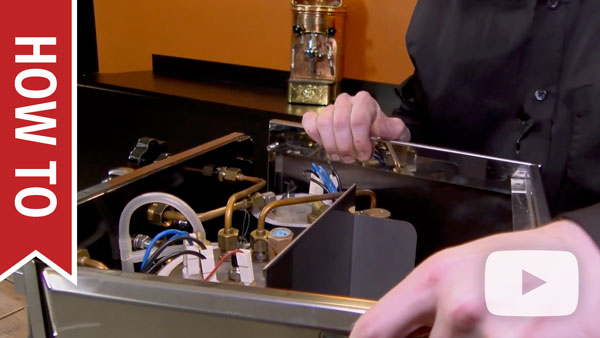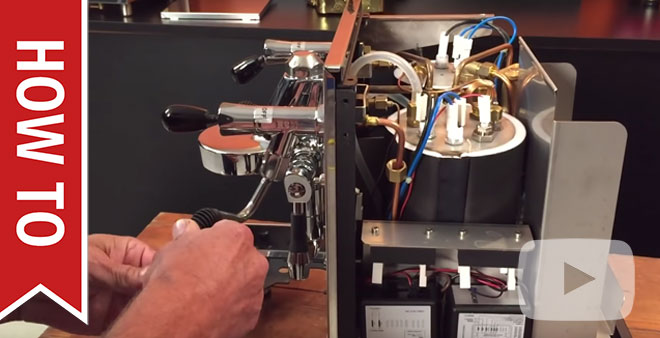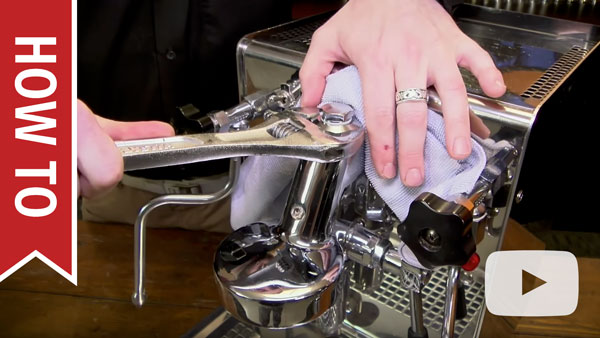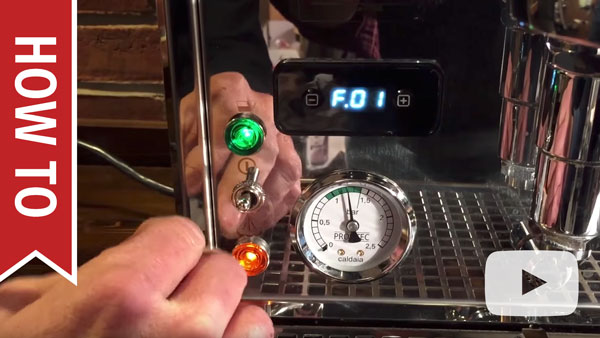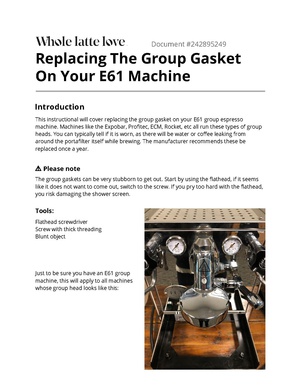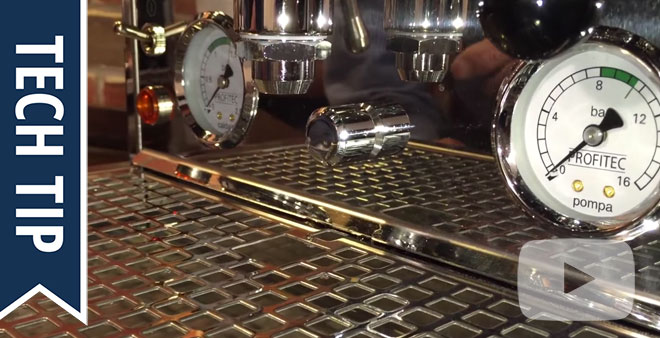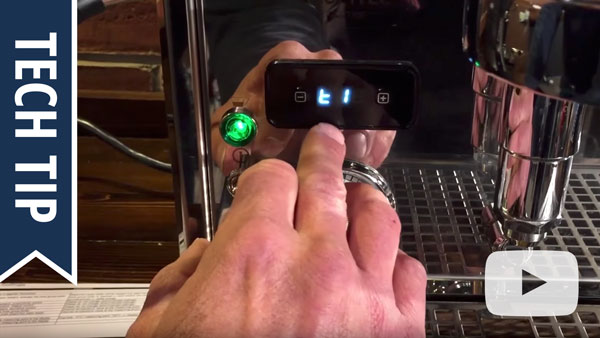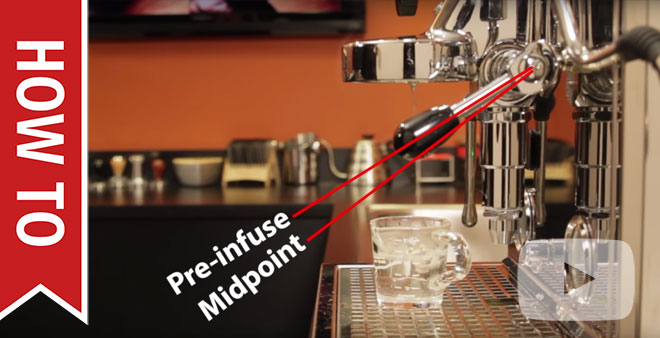Profitec Pro 600/troubleshooting
From Whole Latte Love Support Library
- No Power
- Steam Boiler Not Heating
- Brew Boiler Not Heating
- No Water Flow
- No Flow Out of Hot Water Valve
- No Steam
- No Flow from Brew Group
- Low Steam Pressure
- Low Brew Pressure
- High Brew Pressure
- Group Head Won't Flush
- OPV Leaking
- Pump Keeps Running
- Machine Leaking
- PID Not Working
- Program PID
- Portafilter Too Tight
- Coffee Tastes Bad
- Preinfusion?
My Machine Has No Power, Pops GFCI
NOTE: Prosumers should be on a dedicated 15 amp circuit that is not being shared with other appliances. By default, the brew boiler should heat first and the steam boiler should heat second.
- Is the green light on in the front of the machine when the power switch is flipped? This green light represents that the machine has power.
- If the green light is not illuminated this could indicate an issue with the outlet, the power cord, or the on switch.
- If the green light is on, is the PID on?
- If the PID is not on, this means that power is not being supplied to the rest of the machine. Make sure the water tank is full and sitting properly within the reservoir support.
- If the tank is in place with enough water inside, testing the magnet sensor for the tank would be the first and easiest place to start.
- Remove the tank and have a magnet handy. Standing in front of the machine and looking down at the reservoir support, there is a black sensor, on the left hand side, about halfway down. Hold the magnet over that sensor and see if the PID comes on.
- If it does, then inspect the magnet in the tank. The magnet may have come out of where it sits and would need to be put back. The cap that holds the magnet in place should be flush with the channel that the magnet sits in. If the cap is pushed down too far or has popped upward, it will change where the magnet sits and the sensor may be unable to sense the magnet. Adjust the cap if necessary. Replace the water tank back into the reservoir support.
- No.
- Try testing another appliance on the same outlet. Does this appliance have power?
- If Yes, we recommend having the machine serviced by a tech.
- If you’d like to get in to the machine yourself, let’s rule out heating elements on the Pro 600, first. Begin by unplugging the machine. First, we will test the brew boiler. The brew boiler is on the left side of the machine, if you are facing the front of the Pro 600. To access it, remove the water reservoir. There are four 2.5mm screws holding down the top panel; two in the back corners, and two in the front corners. Remove these screws and take the top off, setting it aside, face up, so as to not scratch the paneling. The left side panel is held in by four 3mm bolts. These bolts need only to be loosened, and do not have to be completely taken out. Look towards the back of the machine where the side panel and the rear panel meet; there is a 3mm screw there. Loosen it.
- Follow the side panel to the front of the machine and you will find the second 3mm. It will be holding the side panel to the frame of the machine, loosen this until you can wiggle the side panel back and forth by hand. Next you can lay down a towel or a pad and rest the machine on its side. You will see the last two 3mm bolts on the underside of the machine that hold the panel. Remove these two bolts. Supporting the now loosened panel with your hand, you can flip the machine upright. Take the bottom of the panel and move it outward a bit away from the machine, slightly push back on the upper left corner of the back panel to separate it from the side panel. The last bolt holding it in place is the front bolt. This is sitting in a little channel within the frame. If you loosened it enough, you should be able to slide the panel down and then push towards the back of the machine, and the panel will come right off. Sometimes, if the bolt is not loose enough or if there are imperfections from manufacturing, the bolt can get hung up. You can take your hand and lightly tape down on the upper corner closest to you, and then lightly tap it towards the back of the machine to slide it out of the channel in the frame it rests in. To preserve the cosmetics of the side-panel, be sure to rest it either on a towel or chrome-side facing upward. Three wires are connected to the bottom plate of the brew boiler: two leads and the ground wire. Unplug the leads, and leave them unplugged. Plug the machine in and turn it on. If the GFCI does not trip, the brew boiler heating element is likely the cause of the issue and needs to be replaced.
- Power down the machine and unplug it. Remove the machine to access the inside of the machine. remove the water reservoir. There are four 2.5mm screws holding down the top panel; two in the back corners, and two in the front corners. Remove these screws and take the top off, setting it aside, face up, so as to not scratch the paneling. The left side panel is held in by four 3mm bolts. These bolts need only to be loosened, and do not have to be completely taken out. Look towards the back of the machine where the side panel and the rear panel meet; there is a 3mm screw there. Loosen it.
- Follow the side panel to the front of the machine and you will find the second 3mm. It will be holding the side panel to the frame of the machine, loosen this until you can wiggle the side panel back and forth by hand. Next you can lay down a towel or a pad and rest the machine on its side. You will see the last two 3mm bolts on the underside of the machine that hold the panel. Remove these two bolts. Supporting the now loosened panel with your hand, you can flip the machine upright. Take the bottom of the panel and move it outward a bit away from the machine, slightly push back on the upper left corner of the back panel to separate it from the side panel. The last bolt holding it in place is the front bolt. This is sitting in a little channel within the frame. If you loosened it enough, you should be able to slide the panel down and then push towards the back of the machine, and the panel will come right off. Sometimes, if the bolt is not loose enough or if there are imperfections from manufacturing, the bolt can get hung up. You can take your hand and lightly tape down on the upper corner closest to you, and then lightly tap it towards the back of the machine to slide it out of the channel in the frame it rests in. To preserve the cosmetics of the side-panel, be sure to rest it either on a towel or chrome-side facing upward. Three wires are connected to the bottom plate of the steam boiler: two leads and the ground wire. Unplug the leads, and leave them unplugged. Plug the machine in and turn it on. Plug the machine in and test. If it keeps power, and doesn’t blow out a GFCI, then the heating element is bad in the steam boiler and needs to be replaced.
- Yes. Electrical testing will need to be done to check the power cord of the espresso machine. Recommend repair or professional.
- No. The problem is your outlet.
My steam boiler is not heating/ Not Steaming and no Hot Water At All
Confirm that water is coming through the group head when the lever is lifted, and that this has been isolated to a steam boiler issue. (You can still get water out of the group head without the boiler being full.We should be making sure the autofill function has successfully filled the boiler. Easiest way, remove the probe from the autofill and let it run for a few seconds, watching the level in the tank and see if it starts to drop. Put probe back on. Do not run this for too long or you will over fill the boiler and water will pour from the safety.
1. Is the steam boiler turned “ON”?
- No. Turn on the steam boiler through the menu in the PID, and wait half an hour to see if the steam boiler will heat.
- Yes. Move on to the next question.
2. Is the PID coming on on the front of the machine?
- No.
- Is the machine plugged in and the power switch on?
- Yes. Move on to the next question
- No. Plug the machine in and turn the power switch on
- Visually inspect the high limit switch.
- Is it melted or broken? Replace it.
- If it is not broken, unplug the machine, and reset it.
- Power the machine on see if it heats
- Test the high limit switch for continuity.
- Does it have continuity?
- Yes. Move on to the next question.
- No. Replace the high limit switch.
- Is the solenoid valve (also called the auto fill valve) clicking, but not filling the boiler?
- Clean the autofill valve.
- YES
- Power down the machine and unplug it. Remove the machine to access the inside of the machine. remove the water reservoir. There are four 2.5mm screws holding down the top panel; two in the back corners, and two in the front corners. Remove these screws and take the top off, setting it aside, face up, so as to not scratch the paneling. The left side panel is held in by four 3mm bolts. These bolts need only to be loosened, and do not have to be completely taken out. Look towards the back of the machine where the side panel and the rear panel meet; there is a 3mm screw there. Loosen it.
- Follow the side panel to the front of the machine and you will find the second 3mm. It will be holding the side panel to the frame of the machine, loosen this until you can wiggle the side panel back and forth by hand. Next you can lay down a towel or a pad and rest the machine on its side. You will see the last two 3mm bolts on the underside of the machine that hold the panel. Remove these two bolts. Supporting the now loosened panel with your hand, you can flip the machine upright. Take the bottom of the panel and move it outward a bit away from the machine, slightly push back on the upper left corner of the back panel to separate it from the side panel. The last bolt holding it in place is the front bolt. This is sitting in a little channel within the frame. If you loosened it enough, you should be able to slide the panel down and then push towards the back of the machine, and the panel will come right off. Sometimes, if the bolt is not loose enough or if there are imperfections from manufacturing, the bolt can get hung up. You can take your hand and lightly tape down on the upper corner closest to you, and then lightly tap it towards the back of the machine to slide it out of the channel in the frame it rests in. To preserve the cosmetics of the side-panel, be sure to rest it either on a towel or chrome-side facing upward. Three wires are connected to the bottom plate of the steam boiler: two leads and the ground wire. Unplug the leads, and leave them unplugged. Plug the machine in and turn it on.
- Is there continuity?
- No. Replace the heating element. Also take note that a bad element can still have continuity so an element should not be dismissed if it has continuity.
My brew boiler is not heating/ Cold water Comes Through the Group
1. Has 20 minutes or so lapsed with the red light off, giving the brew boiler time to heat?
- Yes. Move on to the next question.
- No. Make sure the machine had had 20-30 minutes to fully come to temperature.
2.Is the PID display on?
- No. Check for loose wires to the PID. They will run from the temperature probe on the top of the front boiler to the PID display. They are very thin wires, like speaker wires. They can come loose, or break. Inspect for any damage, and make sure they are tight in the PID.
- Yes. Move on to the next question.
3. Is the PID displaying numbers?
- Yes. The numbers have not been rising. They seem to be stuck at a room temperature setting.
- If the Display is on, and the machine has been sitting for an adequate amount of time without rising, this indicates a heating issue with the brew boiler. Continue on to next question. This could either be a result of the high limit being popped, power not being supplied to the element, or a bad element.
- Yes. The numbers are rising and behaving normally. Move on to the next question.
- No. If the Display is blank, Testing for voltage from the board to the PID is necessary to determine if the control board has failed, or the PID has failed.
- Is the PID displaying any error codes?
- Yes.
- A1 or A3- From the PID error doc: Connection is broken, sensor has no contact. This means that the wires connecting from the PID to the brew boiler have been disconnected or damaged. This requires a visual inspection to confirm. First, turn off the machine and unplug it. The left side panel is held in by four 3mm bolts. These bolts need only to be loosened, and do not have to be completely taken out. Look towards the back of the machine where the side panel and the rear panel meet; there is a 3mm screw there. Loosen it. Follow the side panel to the front of the machine and you will find the second 3mm. It will be holding the side panel to the frame of the machine, loosen this until you can wiggle the side panel back and forth by hand. Next you can lay down a towel or a pad and rest the machine on its side. You will see the last two 3mm bolts on the underside of the machine that hold the panel. Remove these two bolts. Supporting the now loosened panel with your hand, you can flip the machine upright. Take the bottom of the panel and move it outward a bit away from the machine, slightly push back on the upper left corner of the back panel to separate it from the side panel. The last bolt holding it in place is the front bolt. This is sitting in a little channel within the frame. If you loosened it enough, you should be able to slide the panel down and then push towards the back of the machine, and the panel will come right off. Sometimes, if the bolt is not loose enough or if there are imperfections from manufacturing, the bolt can get hung up. You can take your hand and lightly tape down on the upper corner closest to you, and then lightly tap it towards the back of the machine to slide it out of the channel in the frame it rests in. Now, look inside and locate the PID. It is the light-grey box between the front of the machine and the brew boiler. Wires run from the PID to the top of each boiler's temperature probes. Starting from the top of the brew boiler (the closest boiler in this case), black wires run to the PID where black connects link up to multi-colored wires. Check to see if the black wires are connected to the black connectors, or if they are damaged. If the wires are disconnected, connect them. If they are damaged, they will need to be replaced.
- A2 or A4 - Is the machine brand new, or have you been using the machine for some amount of time before the errors displayed?
- If new (or if you've never had an issue before, and no work has been done inside the machine) - There is a fault in the machine, either in the control board, PID, static relay, one of the stats. A repair is recommended.
- If used (or work has been done) - Try swapping the black connectors on the PID. Otherwise, a repair is recommended.
4. Is the little dot on the PID solid? Is the red light on the Static relay solid?
- When the machine is on and the steam boiler is heating, the dot on the PID display and the red dot on the static relay will be solid, they will not blink. When the steam boiler heats and the brew boiler starts to heat up, these lights will still be solid. When the brew boiler fully heats all the way, this is when the light on the static relay will be blinking as well as the dot on the PID display. Blinking on one and not the other would indicate a lack of communication between the components. If the red light is not on at all on the static relay, this would indicate either power is not being supplied to the relay, or the relay itself is not directing power and is therefore faulty, however if this is the case, chances are the brew boiler isn't at temp anyway.
There is no Water flow at all
- Lift the lever. Can you hear the pump?
- No. If the pump does not come on, manually use something to push in the switch behind the brew lever. Can you hear the pump now?
- Yes. Adjust the microswitch behind the lever so it protrudes more, and the lever can reach it when it’s pressing down on it.
- Yes. Move on to I Have No Water Flow At All From The Group
- If the machine is not drawing any water, the back panel of the machine should be removed. The plastic socket that the water reservoir slides into should be inspected. On the inside of the socket is a plastic post that runs through it that pushes the ball bearing in the reservoir valve upwards, allowing water to come through the tank into the socket. The post should be inspected to make sure it is not broken or bent. The socket should be inspected to make sure it is intact and not broken in anyway. This is common due to shipping damage or age, pushing down too hard with the water tank.
- If the socket is fine, the water lines coming off the socket should be looked at to make sure they are not kinked shut. If the water line is kinked shut, no water will come through to the pump, or be able to be forced through via priming.
- If the socket and water lines are fine, you can remove the waterline coming off of the pump and try running the pump to see if water comes through. If it does not, this means either the the pump or the pump motor is faulty or seized. If water does come through, then this could be a sign of a bad solenoid or a blockage in the hydraulic system
There is no water coming out when I open the water valve
Make sure that the steam valve works, and the issue has been isolated to just the hot water side of the machine.
1. Is it showing approx 1.2 bars of pressure?
- Yes.
- Remove the hot water tip. Open the hot water wand. Does water come out?
- Yes. Remove the tip from the hot water tap and test the flow. If flow is restored then the tip needs to be cleaned and reattached. Mineral deposits can easily collect in the screen/holes of the hot water tap, so be sure to clean these thoroughly. Soaking the tip in a solution of hot water and backflushing powder will help remove residues more effectively.
- No. There may be a blockage in the wand of the hot water tap. Clean the wand by using a pipe brush that has synthetic or plastic bristles; metal bristles can damage the wand. Then soak the wand in a solution of hot water and dish soap. Backflushing powders should not be used due to the chemicals, which can cause a reaction that will strip or change certain metals different colors, especially if any type of coating is missing
- No. Allow machine to cool, remove the housing, remove the copper pipe off the back of the hot water valve and check for a blockage if no blockage is present in the valve or the end of the pipe, a blockage is present on the boiler side. Should be sent in for repair/descale of hydraulic system.
There is no steam coming out when I open the steam knob
Make sure that the hot water valve works, and the issue has been isolated to just the steam side of the machine.
1. Is it showing approx 1.2 bars of pressure?
- Yes. Remove the tip from the steam wand. Open the valve. Is there steam coming out of the steam arm?
- Yes. If flow is restored then the tip needs to be cleaned and reattached. Mineral deposits and milk debris can easily collect in the holes of the steam tip, so be sure to clean these thoroughly. Soaking the tip in a solution of hot water and backflushing powder will help remove residues more effectively.
- Yes. Make sure the teflon “no burn” tube that is inside of the steam arm, is not sticking out too far. It can block the holes of the steam tip. You can push this back up into the wand. You can also trim a little bit of the tubing off at the nd, on an angle. This will prevent it from blocking off the holes in the steam tip.
- No. There may be a blockage in the steam arm. Clean the wand by using a pipe brush that has synthetic or plastic bristles; metal bristles can damage the wand. Then soak the wand in a solution of hot water and dish soap. Backflushing powders should not be used due to the chemicals, which can cause a reaction that will strip or change certain metals different colors, especially if any type of coating is missing
- No. Allow machine to cool, remove the housing, remove the copper pipe off the back of the steam valve and check for a blockage if no blockage is present in the valve or the end of the pipe, a blockage is present on the boiler side. Should be sent in for repair/descale of hydraulic system.
I Have No Water Flow At All From The Group
1. Are you using a water softener?
- Yes. Remove it so you can test water flow without it.
- Make sure it is not floating and sucking in air.
- If old replace it.
2. Lift the lever. Can you hear the sound of the pump?
- YES.
- Open the hot water valve. Does the pump refill the boiler?
- YES.
- Remove the nut at the top of the group head and check the valve. It is sometimes called a mushroom valve or jet. Inspect this for any scale or mineral deposits. Clean it really well. Hold it up to a window or a light to make sure that the hole is clear of any scale or minerals. The top of the group head when removed is one piece and to gain access to the jet and the screen the two pieces have to be separated, inside the cap is where the jet and the screen sit. If no improvement, move on to the next step.
- While you have this out, check and see if water is sitting in the group head. This would indicate that water is at least making it out of the brew boiler and in to the group head.
- Remove the shower screen. Hold it up to a light, and see if all of the holes are clear. Soak the screen in cafiza, or purchase a new screen and replace it.
- With the screen removed, remove the jet breaker behind it. This will be flat and can be removed with a flathead, or it will have a bolt and will require a 19mm wrench to remove. This should be inspected for any build up that will block it off.
- Neither of the above solutions have fully restored the water flow to the group. Try doing a full group head teardown:
- No. Is the back of the lever pressing on the microswitch?
- No.
- Press it manually. Is the pump coming on now?
- Yes. Adjust the microswitch so that it sticks out of the front further, so when lifting the lever, it can reach this button, and press down on it.
- No. Remove the housing and look at the microswitch, inspect the wires to make sure they are not disconnected or damaged. Test continuity on the switch.Is there continuity?
- Yes. It’s possible its a bad pump
- Test the pump for continuity.
- Make sure there is voltage going to the pump.
- See My brew pressure is low
- No. Replace the microswitch.
Steam Pressure is Low
1. Can you trust that the gauge is working and reliable?
- Does it drop to 0 when the machine is completely cooled?
- While Steaming?
- The steam gauge is going to drop from 1.2 to.8 on average, when the steam knob is opened. This is normal.
- Has the machine had about half an hour or so to fully come to heat?
- Yes. Move on to the next question.
- No. Leave the machine on for a full half hour to let it come to temp.
- Also make sure the steam boiler is turned on in your PID menu. Instructions for turning on the steam boiler can be found on page 26, section 6.3.2 of your machine's user manual.
- Try adjusting the PID.
- Remove steam tip, hold up to the light and inspect for partial blockage from debris, old milk etc. Clean if necessary.
- Make sure the teflon “no burn” tube that is inside of the steam arm, is not sticking out too far. It can block the holes of the steam tip. You can push this back up into the wand.
My brew pressure is low
1. Do you have the backflush disk in?
- Do you have the backflush disk in? This is the only true test of brew pressure. Coffee has too many variables. The backflush disk gives us a control model. With a rotary pump, and the backflush disk in, the gauge should rise to 9 bars in 4-6 seconds.
- Your brew pressure is truly low, and has been measured with the backflush disk in.
Brew Pressure is High
1. Do you have the backflush disk in?
- This is the only true test of brew pressure. Coffee has too many variables. The backflush disk gives us a control model. With a rotary pump, and the backflush disk in, the gauge should rise to 9 bars in 4-6 seconds.
- What is the brew pressure with the backflush disk in? Is it over 9 bars?
My group head won't flush when I put the lever down
- Move the lever up and down and see if resistance is felt in any direction from the cam moving between actuators (valves). If it will not drain, and not much resistance is felt, remove the bottom of the E61 group head and inspect the actuators. They may be broken, or ground down from poor maintenance that the cam does not make contact with the top of the actuator.
- Remove cam and inspect for flat spots. If the cam is ground down it may not be making contact with the actuator
My OPV is leaking/ water is running out of it
- If the machine is fully heated and still leaking consistently or water is just pouring out of it. Lift the brew lever up and down and listen for a “click” from the intake solenoid. If the solenoid is clicking, removal and cleaning of the intake solenoid is necessary. Definitely do this if the water dripping out becomes steam, and steam is pouring out of the drain.
- With no portafilter in place, lift lever. If no flow out of the group head is present and water is flowing from the Drain, remove the top of the group head and inspect the jet for a blockage.
- If water is just running through out of the discharge and the pump is constantly running. A blockage maybe be present on the intake line into the boiler, this Can be removed and inspected, or the machine will need to be sent in for Repair/ hydraulic system descale.
- The Pro 600 has a line that goes from the top of the vacuum breaker into a plastic T-connector that attaches to the front discharge of the machine. If steam is pouring out of the discharge, it is likely due to a sticking vacuum breaker that will not seal so it is constantly venting steam out of the discharge. The vacuum breaker should be taken apart and cleaned/lubricated. If this does not work then it should be replaced.
The Pump Runs Continuously when Machine is Turned On
- This means that the steam boiler is not filling. The pump will run for about a minute and then turn off. To reset the board you will have to turn off the machine and then turn it back on. If it times out again there is a problem with the water flow. See the video
- If the water leaks out of the top of the boiler then the water sensing circuit is not working properly. It could be:
- Water sensor wire came of the sensor or the board.
- Using mineral free water. Sensors need minerals to operate.
- ADVANCED TECH ONLY:
- Remove the wire off the fill probe and ground it out. Does the pump turn off?
- Yes. Raise the brew lever and see if water comes out of the brew group. If it does we know the pump and water circuit is working fine. The problem is probably in the steam boiler fill solenoid valve. It may be blocked or stuck.
- No. Check the wire leading to the probe and make sure it is on the board and has continuity. If the wire is fine it may be the board.
- If the autofill turns on after removing the wire from the probe, the boiler may already be full.
- Move on to “My steam boiler is not heating”
- In very rare cases, an older machine with bad water and terrible maintenance will build scale up on the probe in the boiler, scale is a poor conductor and can cause issues with the autofill circuit functioning properly. Also make sure the connector is tight on the water level probe, if its too loose, use a pair of pliers to tighten the connector more. You can remove the water level probe and check it for scale. If scale is present you can use fine grit sandpaper to remove it.
- ADVANCED TECH ONLY:
My machine is leaking
1. Is coffee coming up and over the portafilter?
2. Is the leak coming from the lever arm of the machine?
- There are 2 o rings in the lever of the machine. One or both of them may have blown out. You can take apart the lever, and check to see if they are worn. If they seem to be ok, you can lubricate them and see if that resolves the leak. If they are destroyed, they are also easy to replace and very cheap.
3. Is it steaming from above the machine through the vents on top?
- The vacuum breaker is connected to a hose that goes into a plastic “T” connector that attaches to the front discharge of the machine. With age and being subjected to varying heat, this “T” connector can become brittle and break. If that happens, then you will be able to see steam coming out of the top of the machine, as the vacuum breaker is closing, or if it is stuck open. If this is the case, the “T” connector will need to be replaced. If the vacuum breaker will not seal, move to next section.
- Take apart the vacuum breaker and inspect the components, clean all components and remove any buildup or small pieces of debris. Make sure the small o-ring is not broken or too dried out.
- If cleaning it does not resolve the steam leak, replace the vacuum relief valve.
- Is steam pressure too high? Safety valve will vent when steam pressure exceeds a certain point. Try turning down the steam pressure using the PID controller to see if this prevents the safety valve from going off. If this continues there may be an issue with the relay, control board, or PID controller.
- If the safety is still leaking, replace the safety valve. Do not take it apart and clean it. Safety valves contain a teflon diaphragm. On older machines, debris and buildup can form here, this will allow steam to escape when steam pressure is built.
- NOTE: Under no circumstance do we recommend you remove the copper plug and open the safety valve. This could result in incorrectly adjusting the safety, which will then prevent it from blowing off excess steam like it should. The safety should just be replaced.
4. Is the leak or drip coming from the large pipe that comes from behind the group head? (The E61)
- There is one valve above the group head, and two below the group head. One of the two valves may be clogged.
-
- If backflushing shows no improvement, try doing a group head teardown, and replace any valves or o rings in the valves, as needed.
5. Is the leak coming from where the two pipes join in the E61?
- If leaking around the fitting or behind the fitting (where the two pipes join), either under pressure or sitting idle, may require tightening. You do not want to use sealant, as these pipes go into the back of the group head and would be in direct contact with consumable water/ coffee. This could also lock the pipes into the back of the group causing damage to the group which would require replacement of the group. Also contacts with metals is what makes the sealant harden, With how direct tightening is with those pipes you could end up cross threading into the group head thinking it's just the sealant getting hard.
- After tightening the leak still continues, Pipe may need to be replaced, or the fitting is cross threaded and the E61 group needs replacement. Under this circumstance, both parts may require replacement.
- The first is that one of the plumb lines connected to the back of the E-61 is not secure resulting in a leak. This will need to be tightened from the inside of the machine. You may see leaking from the bottom of the machine as well if this is the case. Remove the top of the machine and look towards the front of the machine. These lines will be located on the back of the faceplate, opposite to where the grouphead is seated. They are listed as parts 19 and 11 on p.9 of the machine's parts diagram. Use an open ended wrench or adjustable wrench to tighten these down.
- If they have recently done any group head maintenance on the machine, they may just not have tightened the nut down all the way. Try just turning the nut with a wrench and see if it moves.
6. Is the leak coming from around the nut where the steam or hot water wand attaches?
- If yes: There is an teflon ring in there. It is possible that the teflon ring was bad from the manufacturer. Inside the nut for the steam wand is a small channel that the teflon ring sits inside. You can undo the nut and inspect the teflon for damage or to see if it has moved from the channel in which it sits.
7. Is it dripping or leaking out of the tip of the steam wand?
- Yes. It should leak or drip a little bit after use, and when the machine is first started up. This is normal, and due to condensation in the pipe. It should subside after a few minutes of non use.
- Yes.
- If a leak like this is present, it may be due to either debris in the valve preventing the gasket to seal, or the gasket itself is worn out and no longer seals. Inside of the valve is a long shaft with a round rubber gasket inserted in the end of it. This rubber has either gotten hard with age and no longer seals properly, or the gasket has been over tightened too much and either is not sealing properly, or has shredded.
8. Is the leak coming from between the steam tip and the wand?
If the leak is between the wand and the steam tip, this is most likely due to the rubber o-ring around the steam tip.
9. Is the leak coming from the safety valve?
- What kind of water are you using?
- If you are using distilled water, or reverse osmosis, there will not be enough mineral content in the water for the water level probe to send a ground signal, telling the pump to shut off.
- If pump is still running and water comes out of the safety valve, check that the connector did not come off of the level probe, if it did, reconnect.
- Make sure that the green and yellow ground wire did not come loose from the control board. This usually results in the safety valve spraying like a sprinkler, not just a “leak”.
- Make sure that the wire coming from the autofill going to the board, right next to the ground wire, did not come loose.
- If the safety is still leaking, replace the safety valve. Do not take it apart and clean it. Safety valves contain a teflon diaphragm. On older machines, debris and buildup can form here, this will allow steam to escape when steam pressure is built.
- NOTE: Under no circumstance do we recommend you remove the copper plug and open the safety valve. This could result in incorrectly adjusting the safety, which will then prevent it from blowing off excess steam like it should. The safety should just be replaced.
11. Is the leak coming from the boiler itself?
- Is it leaking from where a valve screws in to the boiler?
- Remove the valve, and clean any remnants of sealant. You can use teflon tape, Permabond, or locktite to reseal the valve back into the boiler.
- Is the leak coming from a weld point on the boiler?
- The boiler must be replaced.
12. I cannot find the source of the leak.
- Run the machine to allow it to heat. Some leaks may only be apparent under heat and pressure.
- You can open the machine and send us any photos or videos, so we can determine if we can find the source of the leak.
- Send the machine in for service.
13. Is the leak coming from the top nut on the group head?
- There is an o-ring that is loose, dirty, or worn out. Take out this mushroom valve, clean any scale or debris, and reseat the valve. All of these parts are separated by teflon rings. It could just be loose and slightly tightening could stop the leak, but with heat and age its possible the teflon is no good. Tightening the bit down more will only further deform the teflon allowing a leak to still continue, these should be replaced.If it is still leaking, replace the gasket that separates it from the top of the group head. To access these parts use an open ended wrench or adjustable wrench to remove the smaller top bolt of the E-61. This will give you access to the first o-ring and spring assembly. To access further down into this part of the grouphead use a wrench to remove the large bolt. This will let you access the other o-ring, another spring assembly, and the valve assembly. Inspect all of these components for integrity. Clean any dirty parts and replace any broken parts. Reassemble the grouphead and see if the leaking is resolved.
- If you’ve recently serviced the group head, It’s possible the nut is just loose. Try tightening it.
14. Is the leak coming from the bottom of the machine?
- Inspect the plastic reservoir valve socket. If it is cracked, it will need to be replaced.
My PID is missing segments/ PID is not coming on
- Inspect the wires in the back of the PID to make sure they are full in the connectors and the connectors are all tight and nothing is unplugged.
- If the Display is missing segments or flickering and the connections are all fine, replace the PID.
- If the Display is blank, Testing for voltage from the board to the PID is necessary to determine if the control board has failed, or the PID has failed.
How do I Adjust the PID?
For an in-depth look at programming your PID, watch the video on the right.
Portafilter is too tight on brand new machine
As long as water is not leaking around the portafilter from the group head, this is totally normal. Over time, the portafilter will wear in to a normal 6 o’clock position. It could take about a month or two. As long as it is making a good seal, then it is fine. In another year or so, the gasket will need to be replaced again, and may still be a little off center in the beginning.
My coffee tastes bitter or sour
Typically, issues with crema or the flavor of the shot do not indicate a malfunction of the machine. Instead, this indicates that an adjustment needs to be made in the brewing process or that different beans need to be used.
- Here is some helpful advice on Tamping.
- Making adjustments to the grind is going to have the biggest impact on the coffee extraction. If it is too coarse, the coffee is going to come through too fast, and not extract long enough.
- If the grind is too fine, it is going to extract for too long, results in really bitter shots.
- It is important to use fresh beans, typically beans roasted within the past two weeks are best. Light and medium roasts are best for espresso brewing and richer crema.
What is Preinfusion?
Pre-infusion is what allows a small amount of water through first, before beginning the shot. It allows this water to saturate the coffee and get the grounds equally wet. This can make the coffee extract more smoothly. Water will always take the path of least resistance. By letting the water saturate the grinds before brewing at 9 bars of pressure, this can help prevent channeling.

